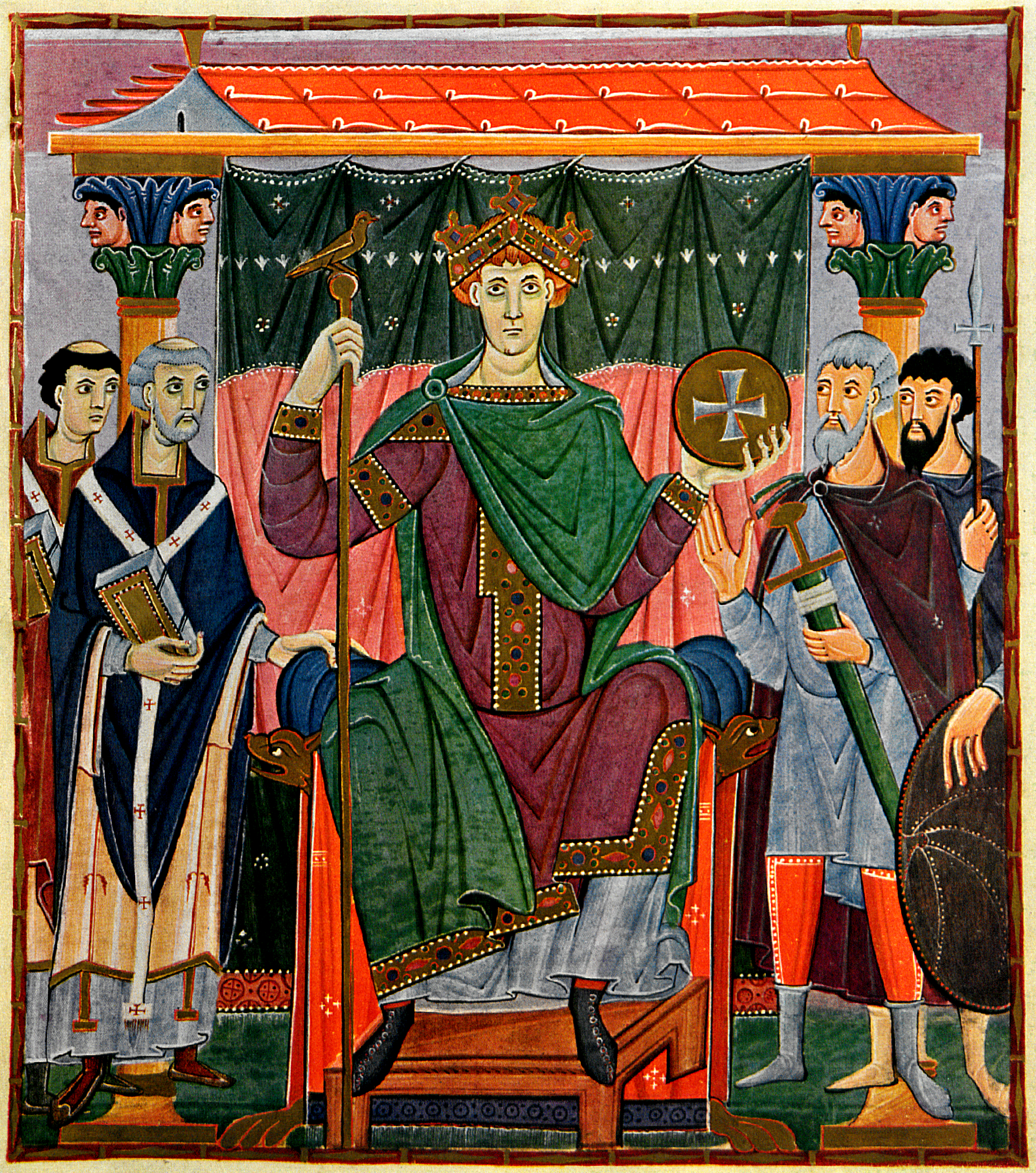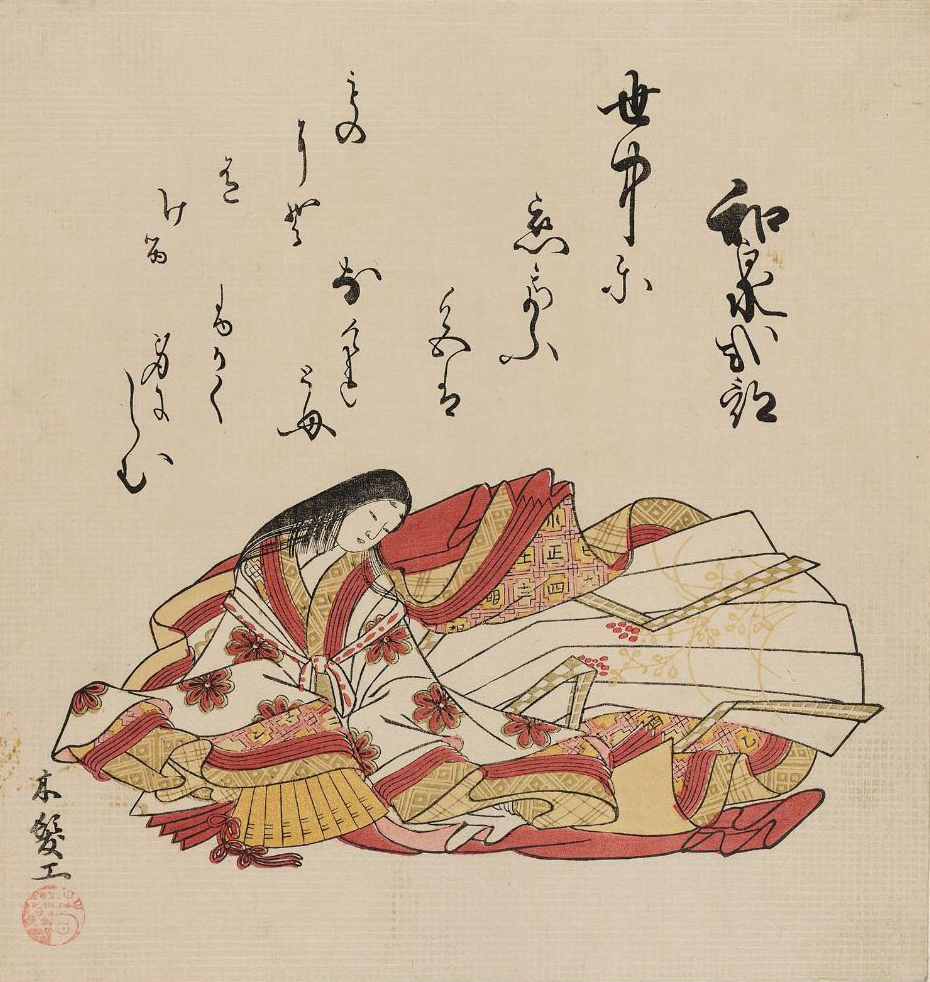|
Fujiwara No Norimichi
, fifth son of Michinaga, was a kugyo of the Heian period. His mother was Minamoto no ''Rinshi'' (源 倫子), daughter of Minamoto no Masanobu. Regent Yorimichi, Empress ''Shōshi'' (consort of Emperor Ichijō), Empress ''Kenshi'' (consort of Emperor Sanjō) were his brother and sisters from the same mother. In 1068, the year when his daughter married Emperor Go-Reizei, he took the position of Kampaku, regent. He, however, lost the power when Emperor Go-Sanjo, who was not a relative of the Fujiwara clan, assumed the throne. This contributed to the later decline of the Fujiwara clan. Marriages and children In 1012, he was married to a daughter of Fujiwara no Kinto by a daughter of Prince Akihira (son of Emperor Murakami), (1000–1024). * ''Seishi'' (or Nariko) (生子) (1014–1068), - married to Emperor Go-Suzaku in 1039 * ''Shinshi'' (or Saneko) (真子) (1016–1087) - Naishi-no-kami 1042–1087 * Nobuie (信家) (1018–1061) - adopted by his uncle Yorimichi * Michimo ... [...More Info...] [...Related Items...] OR: [Wikipedia] [Google] [Baidu] |
Fujiwara No Michinaga
was a Japanese statesman. The Fujiwara clan's control over Japan and its politics reached its zenith under his leadership. Early life Michinaga was born in Kyōto, the son of Kaneiye. Kaneiye had become Regent in 986, holding the position until the end of his life in 990. Due to the hereditary principle of the Fujiwara Regents, Michinaga was now in line to become Regent after his brothers, Michitaka and Michikane. Career Struggle with Korechika Michitaka was regent from 990 until 995, when he died. Michikane then succeeded him, famously ruling as Regent for only seven days, before he too died of disease. With his two elder brothers dead, Michinaga then struggled with Fujiwara no Korechika, Michitaka's eldest son and the successor he had named. Korechika was more popular at court than Michinaga, being a favourite of Empress Teishi and well-liked by the reigning Emperor Ichijō, and held multiple prestigious positions - he had been made Naidaijin the previous year, and San ... [...More Info...] [...Related Items...] OR: [Wikipedia] [Google] [Baidu] |
Empress Shōshi
, also known as , the eldest daughter of Fujiwara no Michinaga, was Empress of Japan from c. 1000 to c. 1011. Her father sent her to live in the Emperor Ichijō's harem at age 12. Because of his power, influence and political machinations she quickly achieved the status of . As empress she was able to surround herself with a court of talented and educated ladies-in-waiting such as Murasaki Shikibu, author of '' The Tale of Genji''. By the age of 20, she bore two sons to Ichijō, both of whom went on to become emperors and secured the status of the Fujiwara line. In her late 30s she took vows as a Buddhist nun, renouncing imperial duties and titles, assuming the title of Imperial Lady. She continued to be an influential member of the imperial family until her death at age 86. Empress In the middle of the 9th century Fujiwara no Yoshifusa declared himself regent to Emperor Seiwa—his young grandson—the Fujiwara clan dominated court politics until the end of the 11th century, ... [...More Info...] [...Related Items...] OR: [Wikipedia] [Google] [Baidu] |
996 Births
Year 996 ( CMXCVI) was a leap year starting on Wednesday (link will display the full calendar) of the Julian calendar. Events By place Japan * February - Chotoku Incident: Fujiwara no Korechika and Takaie shoot an arrow at Retired Emperor Kazan. * 2 March: Emperor Ichijo orders the imperial police to raid Korechika’s residence; Empress Teishi (sister of Korechika) cuts her hair because of the humiliation; Takaie is arrested, Korechika is absent. * 5 March: Korechika returns with his head shaven and attired as a monk. Europe * Spring – King Otto III starts his first expedition to Italy from Regensburg, and proceeds over the Brenner Pass. News of Otto's arrival prompts Crescentius II (the Younger), patrician (the ''de facto'' ruler) of Rome, to invite Pope John XV (exiled in Tuscany) back to Rome. Otto arrives in Verona, and receives ambassadors of Doge Pietro II Orseolo of Venice. * May 21 – Otto III, 16, is crowned Emperor of the Holy Roman ... [...More Info...] [...Related Items...] OR: [Wikipedia] [Google] [Baidu] |
Kodansya
is a Japanese privately-held publishing company headquartered in Bunkyō, Tokyo. Kodansha is the largest Japanese publishing company, and it produces the manga magazines '' Nakayoshi'', ''Afternoon'', ''Evening'', ''Weekly Shōnen Magazine'' and ''Bessatsu Shōnen Magazine'', as well as the more literary magazines ''Gunzō'', '' Shūkan Gendai'', and the Japanese dictionary ''Nihongo Daijiten''. Kodansha was founded by Seiji Noma in 1910, and members of his family continue as its owners either directly or through the Noma Cultural Foundation. History Seiji Noma founded Kodansha in 1910 as a spin-off of the ''Dai-Nippon Yūbenkai'' (, "Greater Japan Oratorical Society") and produced the literary magazine ''Yūben'' () as its first publication. The name ''Kodansha'' (taken from ''Kōdan Club'' (), a now-defunct magazine published by the company) originated in 1911 when the publisher formally merged with the ''Dai-Nippon Yūbenkai''. The company has used its current legal name sin ... [...More Info...] [...Related Items...] OR: [Wikipedia] [Google] [Baidu] |
Izumi Shikibu
was a mid-Heian period Japanese poet. She is a member of the . She was the contemporary of Murasaki Shikibu, and Akazome Emon at the court of empress Joto Mon'in. She "is considered by many to have been the greatest woman poet of the Heian period". Her legacy includes 242 poems and two '' kashu''. "Torn between worldly ties and physical desire, Izumi Shikibu left a wealth of passionate love poetry, fueling rumors that purported that she was a femme fatale with numerous lovers besides her two husbands and two princely lovers." Early life Izumi Shikibu was the daughter of Oe no Masamune, governor of Echizen. Her mother was the daughter of Taira no Yasuhira, governor of Etchu. In 995, at the age of 20, Izumi was married to Tachibana no Michisada, governor of Izumi, the origin for her name. Their daughter was born in 997, Koshikibu no Naishi, who also became a poet. However, Izumi soon divorced, and her former husband died soon afterwards. Introduction by Amy Lowell. As ... [...More Info...] [...Related Items...] OR: [Wikipedia] [Google] [Baidu] |
Emperor Murakami
was the 62nd emperor of Japan, Imperial Household Agency (''Kunaichō'') 村上天皇 (62)/ref> according to the traditional order of succession. Murakami's reign spanned the years from 946 to his death in 967. Biography Before he ascended to the Chrysanthemum Throne, his personal name (''imina'') was Nariakira''-shinnō'' (成明親王). Nariakira''-shinnō'' was the 14th son of Emperor Daigo, and the younger brother of Emperor Suzaku by another mother. Murakami had ten Empresses and Imperial consorts and 19 Imperial sons and daughters. Events of Murakami's reign In 944, he was appointed crown prince and ascended the throne two years later. * 16 May 946 ('' Tengyō 9, 13th day of the 4th month''): In the 16th year of the reign of Emperor Suzaku (朱雀天皇十六年), the emperor abdicated; and the succession (the ''senso'') was received by his younger brother, Nariakira-shinnō. * 31 May 946 (''Tengyō 9, 28th day of the 4th month''): Shortly thereafter, Emperor Muraka ... [...More Info...] [...Related Items...] OR: [Wikipedia] [Google] [Baidu] |
Kōkyū
is the section of a Japanese Imperial Palace called the where the Imperial Family and court ladies lived. Many cultured women gathered as wives of Emperors, and court ladies, as well as the maids for these women; court officials often visited these women for influence, literary charm, or romances. Significant contributions to the literature of Japan were created in the Kōkyū during this period: works such as '' The Tale of Genji'' by Murasaki Shikibu, ''The Pillow Book'' by Sei Shōnagon, and many anthologies of '' waka'' poems. Conflated definitions The term ''"Dairi"'' refers not only to the buildings in which the Japanese Imperial family resided; it also refers indirectly to the women of the Imperial family (the Kōkyū), to the Imperial court of Japan, or as an indirect (now archaic) way of referring to the Emperor himself. The names of the several gates in the walls surrounding the Imperial grounds refer not only to the specific wall-openings themselves; these names wer ... [...More Info...] [...Related Items...] OR: [Wikipedia] [Google] [Baidu] |
Emperor Go-Suzaku
was the 69th emperor of Japan,Imperial Household Agency (''Kunaichō'') 後朱雀天皇 (69)/ref> according to the traditional order of succession. Go-Suzaku's reign spanned the years from 1036 through 1045. This 11th-century sovereign was named after the 10th-century Emperor Suzaku and ''go-'' (後), translates literally as "later;" and thus, he is sometimes called the "Later Emperor Suzaku". The Japanese word "''go''" has also been translated to mean the "second one;" and in some older sources, this emperor may be identified as "Suzaku, the second" or as "Suzaku II." Biography Before his ascension to the Chrysanthemum Throne, his personal name (his ''imina'') was Atsunaga''-shinnō'' (敦良親王). His father was Emperor Ichijō. His mother was Fujiwara no Akiko/ Shōshi (藤原彰子), the daughter of Fujiwara no Michinaga (藤原道長). He was the younger brother and heir to Emperor Go-Ichijō. Go-Suzaku had five Empresses and seven Imperial children.Brown, p. 311. ... [...More Info...] [...Related Items...] OR: [Wikipedia] [Google] [Baidu] |
Fujiwara No Kinto
Fujiwara (, written: 藤原 lit. "''Wisteria'' field") is a Japanese surname. (In English conversation it is likely to be rendered as .) Notable people with the surname include: ; Families * The Fujiwara clan and its members ** Fujiwara no Kamatari ** Fujiwara no Fuhito ** Fujiwara no Michinaga * Northern Fujiwara clan ** Fujiwara no Kiyohira ; Art and entertainment * Fujiwara (owarai), Japanese comedy duo (kombi) consisting of Toshifumi Fujimoto (藤本敏史) and Takayuki Haranishi (原西孝幸) * Atsushi Fujiwara (born 1963), Japanese photographer * Harry Fujiwara (Mr. Fuji) (1934 - 2016), Japanese-American wrestler * Hiroshi Fujiwara (born 1964), Japanese musician, trendsetter, producer, and designer * Kamatari Fujiwara (1905 - 1985), Japanese actor * Kei Fujiwara (born 1957), Japanese actress and film director * Keiji Fujiwara (1964 - 2020), Japanese voice actor * Motoo Fujiwara, lead singer and composer for the Japanese rock band Bump of Chicken * Tokuro Fujiwara, Japa ... [...More Info...] [...Related Items...] OR: [Wikipedia] [Google] [Baidu] |
Emperor Go-Sanjo
An emperor (from la, imperator, via fro, empereor) is a monarch, and usually the sovereign ruler of an empire or another type of imperial realm. Empress, the female equivalent, may indicate an emperor's wife ( empress consort), mother ( empress dowager), or a woman who rules in her own right and name (empress regnant). Emperors are generally recognized to be of the highest monarchic honor and rank, surpassing kings. In Europe, the title of Emperor has been used since the Middle Ages, considered in those times equal or almost equal in dignity to that of Pope due to the latter's position as visible head of the Church and spiritual leader of the Catholic part of Western Europe. The Emperor of Japan is the only currently reigning monarch whose title is translated into English as "Emperor". Both emperors and kings are monarchs or sovereigns, but both emperor and empress are considered the higher monarchical titles. In as much as there is a strict definition of emperor, it is ... [...More Info...] [...Related Items...] OR: [Wikipedia] [Google] [Baidu] |



.jpg)


